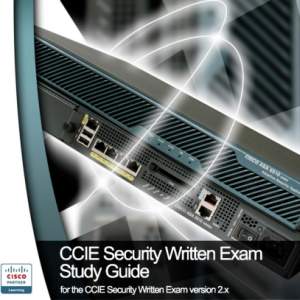
How to prepare for the CCIE Written Exam? CCIE consultant Mark Lewis wrote an article “How to pass the CCIE Voice written exam”, more detailed info, tips as well as experience for CCIE Voice Written Exam Preparation. Let’s read it.
The CCIE Voice written exam consists of 100 multiple choice questions, covering a wide range of topics. Preparation for the exam will consist, to a very large extent, of reading.
The amount of reading will depend, of course, on your level of knowledge and expertise in each of areas covered by the exam. In order to maximize the efficacy of your study and minimize the amount of reading that you have to do, it’s very important to select the correct preparation resources (books and documents).
But before taking a closer look at preparation resources, first take a look at the exam blueprint (at Cisco.com, CCIE Voice Written Exam). It’s a good idea to print it out, and take a few minutes to carefully consider how strong you are in relation to each of the objectives. Once you have assessed yourself against the main objectives, you can decide in which order you want to tackle them when preparing for the exam.
You may decide to approach the blueprint in a top-down fashion – just start with CallManager, and run through the objectives one-by-one. Or you may decide to fill in the gaps with subjects where are stronger before tackling those subjects where you are weaker. Or you may even decide to tackle the toughest subjects first, while enthusiasm is highest!
Don’t be under any illusions when tackling the CCIE Voice written – it may, depending on your current level of knowledge and experience, take some substantial effort. But console yourself with the fact that reading through all of the resources necessary to pass the written exam will give you a great platform to go for the lab exam.
One of the particular difficulties of the CCIE Voice written exam is that there is relatively little overlap between the CCIE Voice track and the other tracks. So, if you are coming from a routing/switching background then the learning curve for this exam may be pretty steep. Having said that, it is definitely possible to pass the CCIE Voice written exam with a little study.
It’s probably best to set aside a certain amount of time every day to study for the written exam, and stick to that schedule. You may find it useful to (briefly) record in a journal what exam preparation you do every day.
So, let’s have a look at study resources that you can use in preparing for the exam.
Exam Objective 1: CallManager
The first item on the blueprint is CallManager (CCM). If you know anything at all about Cisco’s enterprise IP telephony products and solutions, then you’ll know that their solution is centred on CCM. Given this fact, it’s a pretty good bet that you’ll have to have a pretty firm grasp of CCM in order to pass the written exam.
If you have passed the CCVP 642-444 CIPT-4.x (Cisco IP Telephony for Release 4.x) exam then you’ll have a good base for CCM related questions on the exam, but you will probably need to add to your knowledge.
So, what are the best resources for someone preparing for the CCM portion of the CCIE Voice written? Well, the ‘Cisco CallManager Fundamentals, Second Edition’ (Cisco Press) is an excellent book for preparing for the exam. In addition, ‘Cisco Unified Communications SRND Based on Cisco Unified CallManager 4.x’ is also essential reading.
You can find ‘Cisco Unified Communications SRND Based on Cisco Unified CallManager 4.x’, together with other Solution Reference Network Design documents (SRNDs) here. Other documents referenced in this blog post can easily be found by searching for them on the Cisco website. Another resource that you may want to read is ‘Cisco IP Video Telephony Solution Reference Network Design (SRND) Cisco CallManager Release 4.0’.
Having read the book and documents (and understood and remembered them!), you should be in fairly good shape for the CCM portion of the exam.
Exam Objective 2: QoS
Next on the blueprint is Quality of Service (QoS). If you come from a routing and switching background, this one of the few areas where you may be able to leverage existing knowledge.
Two resources that are very useful in preparation for the QoS related aspects of the written exam are ‘End-to-End QoS Network Design: Quality of Service in LANs, WANs, and VPNs’ (Cisco Press) and ‘Enterprise QoS Solution Reference Network Design Guide’.
Exam Objective 3: Telephony Protocols
Third on the list of possible exam topics listed in the blueprint is ‘Telephony Protocols’. These telephony protocols include MGCP, SIP, H.323, SCCP, RTP/cRTP, and analog/TDM signalling.
Pretty much all IP telephony related books will cover these protocols to some extent, but two books that are perhaps more focused on them than other books are ‘Voice Over IP Fundamentals’ (Cisco Press) and ‘Integrating Voice and Data Networks’ (Cisco Press). ‘Integrating Voice and Data Networks’ is now out-of-print, so you may have to resort to ebay in order to get hold of a copy. Alternatively, you can read it online at the Safari website.
‘Voice over IP Fundamentals’ and ‘Integrating Voice and Data Networks’ also cover areas not required for the written exam. For example, based on a quick read of the blueprint, it’s probably a fair bet that SS7 is not going to be a major focus of the exam. So, you can probably save some valuable time by reading only the chapters of these two books that cover subjects shown in the blueprint.
Exam Objective 4: Unity
Next is Unity. A good start will be ‘Cisco Unity Fundamentals’ (Cisco Press). Once you have read that, a good book to read in order to bring your level of knowledge up to a more advanced level is ‘Cisco Unity Deployment and Solutions Guide’ (Cisco Press).
Exam Objective 5: IOS IP Telephony Skills
IOS IP Telephony skills include SRST, CME, and CUE.
One very useful book to read when preparing for the exam is ‘Cisco IP Communications Express: CallManager Express with Cisco Unity Express’.
Useful documents include ‘Cisco Unified CallManager ExpressSolution Reference Network Design Guide’ and ‘Cisco Unity Express Design Guide’. Useful information on SRST can be found here.
If exam day is approaching and you need to get up to speed quickly, it’s probably a good idea to read the documents first followed by the book (if you have time).
Exam Objective 6: IP IVR/IPCC Express
Okay, so much for CME, SRST, and CUE. But how about the next exam objective, IP IVR/IPCC Express?
It is a little more difficult to find good resources for IP IVR/IPCC simply due to the fact that there haven’t been any books published on the subject. So, a little more digging around for good information is required.
A good place to start is the ‘Cisco IPCC Express Edition Solution Reference Network Design’. This is good, but it will almost certainly not be enough to bring you up to the level of knowledge required for the exam.
Supplement the SRND with other resources including Cisco Customer Response Solutions Administration Guide, Cisco Customer Response Solutions Editor Step Reference Guide (Cisco CRS Scripting and Development Series: Volume 2), and Cisco Customer Response Solutions Getting Started with Scripts (Cisco CRS Scripting and Development Series: Volume 1).
Exam Objective 7, 8, 9, and 10: Security, Infrastructure protocols, Application Protocols, Operation and Network Management
Information on the last four exam objectives (security, infrastructure protocols, application protocols, operations and network management) cannot be found in one particular book or document.
One excellent book to read is, ‘Troubleshooting Cisco IP Telephony’. Other than that book, you’ll find information about these exam objectives sprinkled throughout a number of the books and documents that I have already mentioned.
The approach that I recommend with regard to these exam objectives is to leave them until last, read ‘Troubleshooting Cisco IP Telephony’, and then fill in any gaps in your knowledge.
Final Preparation:
So, you have stepped through all the study resources mentioned above, and you are almost ready to book the exam. One last resource that will be very useful is my ‘CCIE Voice Exam Quick Reference Sheets (Digital Short Cut)’. This will help you to quickly fill in any gaps in your knowledge, and also give you a good idea of the level of knowledge that you are going to need in order to pass the exam.
At this point, you’ll be ready to book your exam. Before finishing it is worth mentioning time management for the exam. Don’t forget that there are 100 questions to answer in 120 minutes. So, that’s just a little over a minute per question. Don’t get sucked into spending too much time on one question. If you have a problem with a question, mark it and go back to it at the end.
The CCIE Voice Written exam requires a much deeper understanding of the CCVP topics – plus many more topics that are not covered within the CCVP – see the blueprint below. In fact, the first time I took the CCIE Voice Written (I passed on my second attempt) – I was really caught off guard at the shear scope of the topics you will need to know for the CCIE Voice written.
Suggested Reading for CCIE Voice Written
The following list is from the mouth of Ben Ng (in charge of the Cisco CCIE Voice program), the following books are recommended reading to prepare for the CCIE Voice written exam. This is still current as of today – but an update is in the works.
For the CCIE Voice Written exam, I’d recommend the following (Cisco Press books). And please study it with the written exam blueprint topics in mind.
1. Cisco Voice over IP, Third Edition (Kevin Wallace)
2. Cisco Voice Gateways and Gatekeepers (Donohue, Mallory, Salhoff)
3. Voice over IP Fundamentals, 2nd Edition (Jonathan Davidson, James Peters, Manoj Bhatia, Satish Kalidindi, Sudipto Mukherjee)
4. Cisco IP Communications Express: CallManager Express with Cisco Unity Express (Danelle Au, Baldwin Choi, Rajesh Haridas, Christina Hattingh, Ravi Koulagi, Mike Tasker, Lillian Xia.)
5. End-to-End QoS Network Design: Quality of Service in LANs, WANs, and VPNs (Tim Szigeti, Christina Hattingh)
6. SIP Trunking (Christina Hattingh, Darryl Sladden, ATM Zakaria Swapan)
More Cisco Certification Tips:





